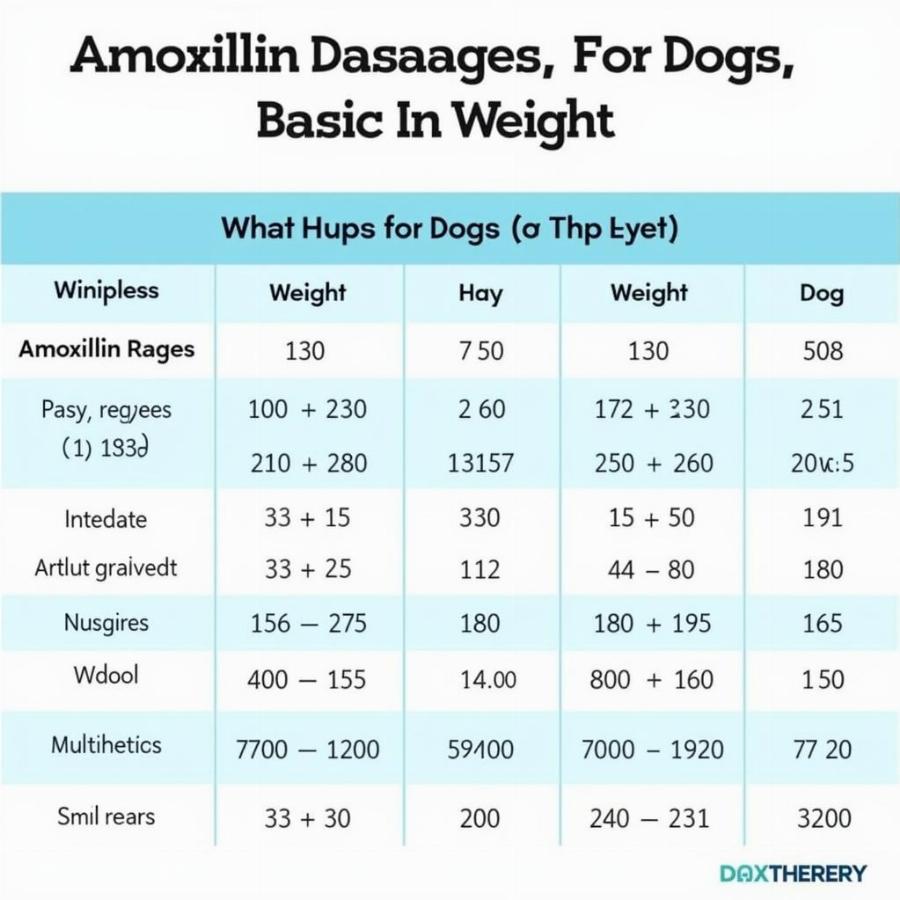Amoxicillin is a commonly prescribed antibiotic for dogs, used to treat a variety of bacterial infections. Understanding the correct dosage of amoxicillin for dogs is crucial for effective treatment and to avoid potential side effects. While this article provides valuable information, it’s essential to remember that it should not replace professional veterinary advice. Always consult your veterinarian before administering any medication to your dog, including amoxicillin. They can diagnose the specific infection and prescribe the appropriate dosage based on your dog’s individual needs.
Understanding Amoxicillin for Dogs
Amoxicillin belongs to the penicillin family of antibiotics and works by inhibiting bacterial growth. It’s effective against a range of infections, including skin infections, urinary tract infections, respiratory infections, and ear infections. However, not all infections are susceptible to amoxicillin, so a proper diagnosis from your vet is essential.
What happens if you give a dog too much amoxicillin? Overdosing can lead to a range of side effects, from mild gastrointestinal upset to more serious neurological issues. That’s why it’s so important to adhere to your veterinarian’s prescribed dosage.
Factors Influencing Amoxicillin Dosage for Dogs
Several factors influence the appropriate amoxicillin dosage for your dog. These include:
- Weight: The dog’s weight is the primary factor determining the dosage. Heavier dogs generally require higher doses.
- Type of Infection: Different infections may require different dosages. For example, a severe infection might need a higher dose than a mild skin infection.
- Severity of Infection: The severity of the infection also plays a role. A more severe infection will likely require a higher dosage.
- Dog’s Overall Health: Underlying health conditions can influence the dosage and choice of antibiotic.
 Amoxicillin Dosage Chart for Dogs
Amoxicillin Dosage Chart for Dogs
How is Amoxicillin Administered to Dogs?
Amoxicillin for dogs typically comes in tablet or liquid form. Follow your veterinarian’s instructions carefully for administration. Some tips for administering amoxicillin to your dog include:
- Tablets: You can hide tablets in food, or use a pill popper to administer them directly.
- Liquid: Use the provided syringe or dropper to measure the correct dosage. Administer the liquid directly into your dog’s mouth.
What if I Miss a Dose?
If you miss a dose, give it as soon as you remember. However, if it is close to the time for the next dose, skip the missed dose and continue with the regular schedule. Never give a double dose to compensate for a missed one.
Potential Side Effects of Amoxicillin in Dogs
While generally safe, amoxicillin can cause side effects in some dogs. Common side effects include:
- Vomiting
- Diarrhea
- Loss of appetite
- Lethargy
If your dog experiences any of these side effects, contact your veterinarian. In rare cases, more serious allergic reactions can occur.
Amoxicillin/Clavulanate (Clavamox) for Dogs
Amoxicillin is also available in combination with clavulanate potassium (Clavamox). Clavulanate helps prevent bacteria from becoming resistant to amoxicillin, making it effective against a wider range of infections. The dosage for Clavamox is also determined by your veterinarian based on your dog’s individual needs.
Conclusion
Knowing the appropriate dosage of amoxicillin for dogs is essential for successful treatment. However, always consult your veterinarian for a proper diagnosis and personalized dosage recommendations. Never self-medicate your pet, as this can be dangerous and ineffective. By working closely with your vet, you can ensure your furry friend receives the best possible care.
FAQs
-
Can I give my dog human amoxicillin? No, never give your dog human medication without consulting your veterinarian. Human formulations can contain different ingredients and dosages that can be harmful to pets.
-
How long does it take for amoxicillin to work in dogs? You should start to see improvement within a few days, but it’s important to complete the entire course of antibiotics as prescribed by your veterinarian.
-
What should I do if my dog vomits after taking amoxicillin? Contact your veterinarian immediately. They may recommend giving the medication with food or adjusting the dosage.
-
Can amoxicillin be given with food? Yes, amoxicillin can be given with or without food.
-
Is amoxicillin safe for pregnant dogs? Your veterinarian will determine if amoxicillin is safe to use during pregnancy based on the specific situation.
-
What are the signs of an amoxicillin overdose in dogs? Signs of an overdose can include severe vomiting, diarrhea, tremors, and seizures. Contact your veterinarian or an emergency animal hospital immediately if you suspect an overdose.
-
Can amoxicillin treat all bacterial infections in dogs? No, not all bacterial infections are susceptible to amoxicillin. Your veterinarian will determine the appropriate antibiotic based on the type of infection.
Further Reading
For more information on related topics, you may find these articles helpful: dosage of amoxicillin for dogs, amoxicillin for dogs dosage chart kg, and amoxicillin dose for dogs. You might also be interested in learning about amoxicillin/clavulanate for dogs dose and clavamox dose dogs.
Beaut Dogs is your trusted source for all things related to dog care, offering comprehensive guides and expert advice. For personalized guidance, please contact us via Email at [email protected]. We’re here to help you provide the best possible care for your beloved canine companion. Visit us at Beaut Dogs to explore a world of valuable information and resources for dog lovers.